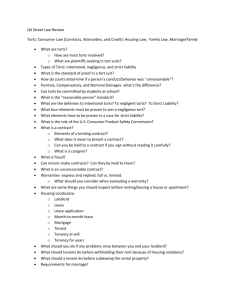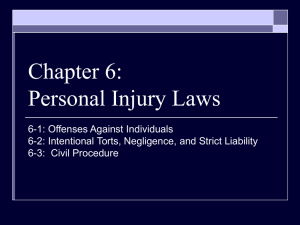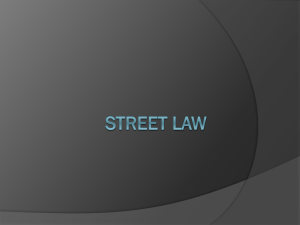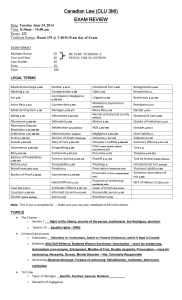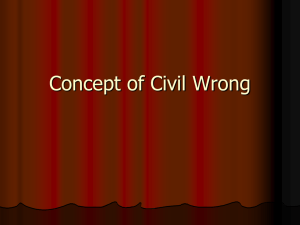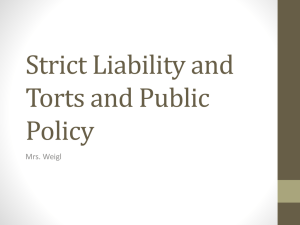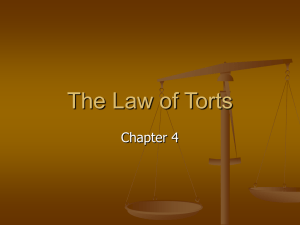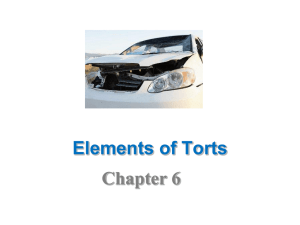Torts - Brimley Area Schools
advertisement
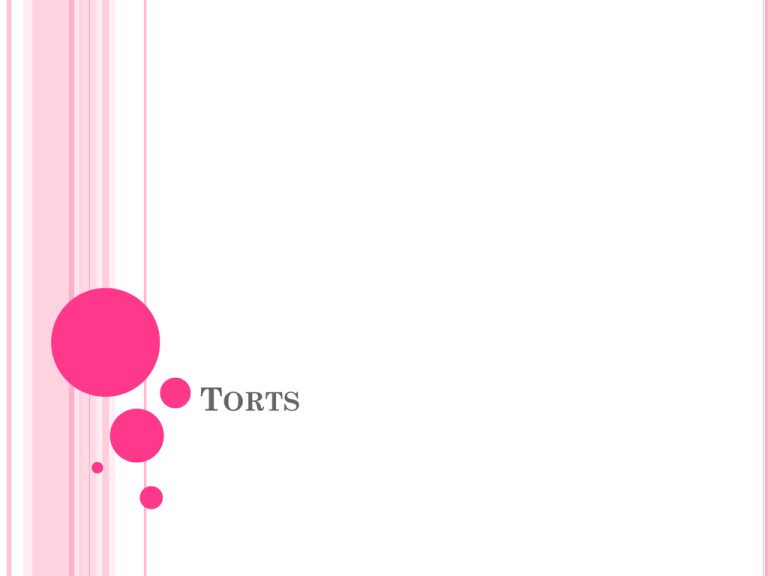
TORTS TRUE OR FALSE? Wrongs against individuals are called crimes. False Wrongs against individuals are called TORTS. TRUE OR FALSE? The vast majority of tort cases are resolved through settlements. True TRUE OR FALSE? Tort law balances the usefulness of certain conduct against the harm that conduct might create. True TRUE OR FALSE? Torts cannot be committed by students at school. False. TRUE OR FALSE? Intentional torts require that the person intended to cause harm. True. The relationship of torts to crimes is a. b. c. d. Intentional torts are generally crimes. Misconduct causing injury is either a crime or a tort but never both. Negligence torts are generally crimes. None of the above Answer: A Intentional torts (batter, e.g.) are generally crimes too! The harmed individual in a tort is called this. The Plaintiff The accused wrongdoer in a tort is called this. The Defendant. In tort law, this term means one is “responsible” for harm done. Liable. Plaintiffs in tort suits are seeking a(n) a. Waiver b. Tort c. Remedy d. immunity Plaintiffs are seeking a remedy. What is the standard of proof in a tort suit? Preponderance of the evidence. TRUE OR FALSE? Juan shakes his fist at Javier’s face and states that Javier is going to get it. Juan has committed a battery. False A threat is an assault. This type of tort is involved when someone unlawfully exercises control over the personal property of another. It can also be an intentional tort. Conversion What type of damages may be awarded to punish the defendant for malicious, willful, or outrageous injury or loss? Punitive Damages What are symbolic damages that show the plaintiff was wronged even though there was not substantial injury or loss called? Nominal Damages Jorie slipped and spilled his hot coffee on Tim. Tim retaliated by throwing his lemonade on Jorie. Jorie committed A. No tort B. Assault C. Battery D. Infliction of Emotional Distress A Jorie committed NO TORT Which of the following is a defense to intentional torts? A. Consent B. Negligence C. Insanity D. Assumption of Risk A; Consent A person can get a patent on a(n) A. Song B. Book C. Invention D. Movie C: A person gets a patent on INVENTIONS. An invention that is in the public domain means that A. Someone has the exclusive right to sell and profit from the invention. B. Anyone may sell and profit from the invention. C. There is a monopoly on the invention. D. The invention can grant the right to sell the invention to another person. Answer: B Anyone may sell and profit from the invention. Copyrights protect A. any expression that is registered with the copyright office. B. any invention that is novel or truly new. C. any invention that is created. D. any expression that is somehow fixed (written down or stored on a computer disk). D Copyrights protect any expression that has been saved somehow. Negligence refers to A. Inattentiveness B. Lack of care about others. C. Forgetfulness. D. Unreasonable conduct Negligence is D Unreasonable conduct. What are the four elements that have to be proven to win for a Negligence Tort? Duty, Breach, Causation, Damages Jake, a city employee working in a manhole, forgets to replace the cover over the street. No one falls in. Jake has not committed negligence because this element of negligence is missing. A. Duty B. Breach C. Proximate cause D. injury D; Injury This occurs when there is an unreasonable interference with your ability to use and enjoy your property. Nuisance. If the harm would not have occurred without the wrongful act, this is A. Proximate cause B. Actual cause C. Cause in fact D. All of the above C; Cause in Fact! What three activities typically fall under Strict Liability? Dangerous Activities; Dangerous Animals; Dangerous Products The reasonable person in tort law refers to the A. Typical person B.. Average person C. Idealized version of a typical, average person D. None of the above C; idealized version of a typical, average person. Which is a consequence of holding manufacturers strictly responsible for defective products? A. Higher insurance rates B. More research and development C. Lower prices for consumers. D. Dangerous products B: More Research and Development This is an intentional tort in which one person harms another’s reputation by false statements made to a third party. Defamation. This type of property includes one’s house and land. Real Property. ___________may have to pay damages to a property owner for unlawfully entering onto the owner’s property even though no harm was done to the property. Trespasser. The most commonly used legal defense to intentional torts is ____________. Consent. What is a common defense when a plaintiff sues for injury caused by a product of the manufacturer? Misuse of the product. Which of the following defenses result in any liability for the defendant? Contributory negligence Comparative negligence Assumption of risk B; Comparative Negligence Are compensatory damages available in a negligence suit? Yes Is incarceration available in negligence suits? NO Being wrongfully confined against one’s will. False imprisonment. A claim brought against the plaintiff by a defendant in a civil lawsuit. counterclaim Money paid to a plaintiff for injuries or losses suffered. Damages. Unauthorized use of another’s patent or copyright. Infringement Oral statements that harm another person's reputation Slander. Responsibility of care owed to others. Duty Divides losses based on the degree to which each person is at fault. Comparative negligence. What elements are necessary to prove in strict liability torts? Causation and Damages only.
